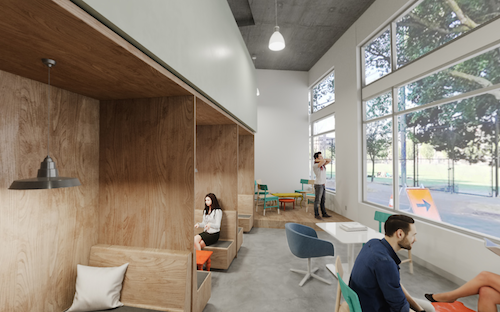Meet the new Hugo House — and learn how you can help make it happen

“All our legislators have just been fabulous” in their support of the organization, Hugo House Executive Director Tree Swenson tells me over the phone. “All three of our representatives — Nicole Macri, Jamie Pedersen, and Frank Chopp — have all been amazing. The Hugo House adores all of them.”
A little bit of backstory: In May of 2016, the old House — built from an old funeral home facing Cal Anderson Park on Capitol Hill — closed its doors forever. For the last year and a half, a construction team has been building an apartment building on the site, with ground-floor retail space that was intended to be the new Hugo House.
This grant money puts the House on track to be complete by this coming summer. But now they need your help to fill in the final gaps.
You can see the plans for the new Hugo House online. It’s really something: 9,600 square feet of arts space including a 150-seat theater, a garden patio, a bar with plenty of cozy alcoves for writing, a cabaret space, six classrooms allowing the House to serve about half again as many students as before. Best of all, the whole space is finally ADA-compliant, meaning that everyone in the community can take part in every event the House puts on. The designs, by Seattle architecture firm NBBJ, incorporate elements from the original House (floorboards from the old building — complete with words drawn on them during the raucous closing-week party in May of 2016 — will make up the bar in the new space.)
Now that the grant has come through, Swenson says the new space “feels more real,” and she’s really getting a sense of what it will be like to walk around NBBJ’s designs. “It feels like a space that is so creative,” she gushes. “It feels like something creative must happen there, and I think that's so awesome.”
That one million dollars from the state puts the house within 90 percent of its final goal. Now they’re making an appeal directly to you. “At this point, we need everyone in the community to give as generously as they possibly can to help us complete this project,” Swenson says.
You can donate to the House through the New Hugo House site. Swenson thinks the designs of the new building will excite the community enough to get the project across the finish line. “I know there are a lot of people who really care about Hugo House whose lives have been changed by experiences they've had there— a lot of writers whose work has been formed and shaped there,” Swenson says. “We're counting on this community to pitch in to help us get to the final goal in the campaign.”
For me, the most exciting part of the new designs is the salon and stage in the picture at the top of this post. It’s a relatively small space — I expect the theater will be put in use for most of the readings at the new Hugo House — but I love that it’s so outward-facing, that it practically spills events out onto the street. It’s what you want a writing center to be: a house, yes, where people come to be comfortable, but also a place that’s reaching outward, inviting everyone to take part.
For the last year and a half, the Hugo House has operated out of temporary quarters — the building generously provided by the Frye on First Hill for instance, and the Fred Wildlife Refuge for big events. That’s been a great thing for the organization, Swenson tells me. It’s introduced the House to people who otherwise never would have known about it. But now it’s time for the community to come together one more time and help the House come home.